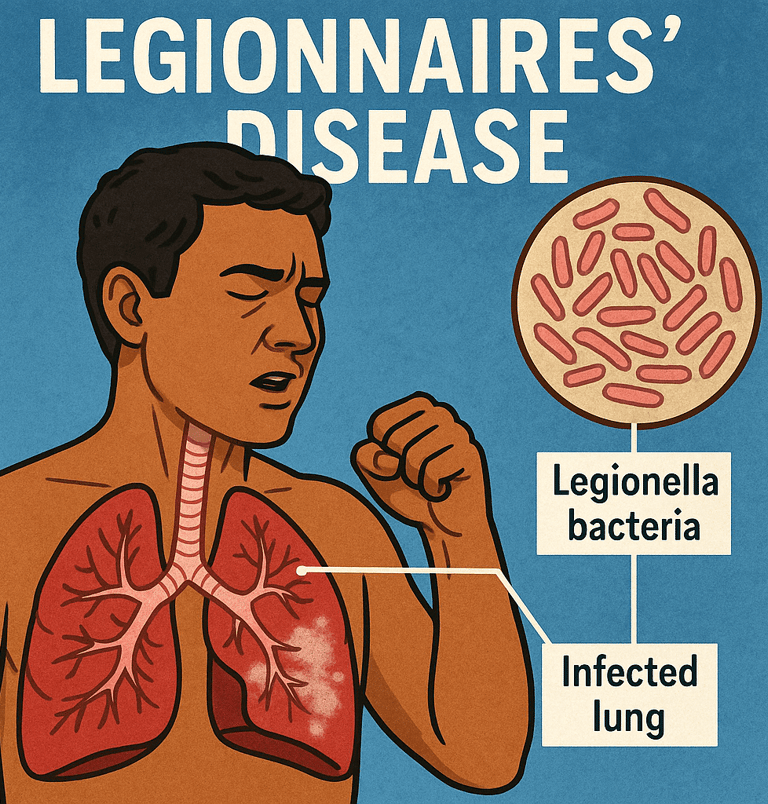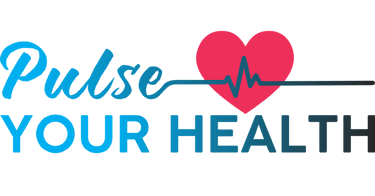Stay updated on what is trending in health. Discover tips and resources for a healthier, balanced life.
Legionnaires' Disease: A Hidden Waterborne Threat
Legionnaires' disease is a serious lung infection caused by Legionella bacteria, often linked to contaminated water systems. Learn the symptoms, causes, prevention tips, and treatment options in this easy-to-understand guide.
DISEASES AND CONDITIONS
Dr. S. Ali
9/21/20254 min read


Legionnaires’ disease is a serious form of pneumonia caused by Legionella bacteria, often found in warm water sources. It typically affects the lungs when someone inhales aerosolized droplets—tiny mist—from systems like cooling towers, hot tubs, showerheads, or fountains. Although most people exposed to Legionella don’t get sick, certain groups—such as older adults, smokers, and those with weakened immune systems or chronic lung conditions—are at a higher risk.
Once inhaled, Legionella bacteria invade lung macrophages—immune cells—where they multiply and eventually cause cell death, leading to inflammation and pneumonia symptoms. Symptoms usually appear within 2 to 14 days—but sometimes can be delayed by up to 20 days.
What Are the Symptoms?
Fever and chills
A sudden high fever (often over 39°C or 102°F) with chills is usually one of the first signs, indicating the body’s immune response to infection.Headache and muscle pain
These flu-like symptoms can feel intense and are caused by inflammation and the body’s reaction to bacterial toxins.Fatigue and weakness
You may feel extremely tired or weak, often before respiratory symptoms begin, which can interfere with daily activities.Persistent cough
The cough may be dry or produce mucus, and in more serious cases, may be tinged with blood—suggesting lung involvement.Shortness of breath
Breathing can become labored due to lung inflammation or fluid buildup, especially if pneumonia develops.Chest pain
This pain can be sharp and worsens with deep breaths or coughing, often mistaken for a heart issue at first.Gastrointestinal symptoms
Nausea, vomiting, diarrhea, and loss of appetite are common and may occur before or alongside respiratory symptoms.Confusion or cognitive changes
In severe cases, especially in older adults, Legionnaires’ can affect the brain, causing disorientation, memory issues, or even hallucinations.Sweating and rapid heart rate
Excessive sweating and a racing pulse can occur due to fever and systemic inflammation.Pontiac fever (milder form)
Pontiac fever is a milder illness caused by the same Legionella bacteria responsible for Legionnaires’ disease. Unlike Legionnaires’, it doesn’t cause pneumonia or affect the lungs. Instead, it presents with flu-like symptoms such as fever, headache, and muscle aches, and usually resolves on its own within a few days without the need for antibiotics. While the source and transmission are the same—typically inhaling contaminated water droplets—Pontiac fever is not life-threatening and requires only supportive care.
Who’s Most at Risk?
While healthy people rarely develop the disease after exposure, those at higher risk include individuals aged 50 or older, current or former smokers, people with lung conditions (like COPD), diabetes, kidney or liver disease, immunocompromised states, or recent hospitalization. Travel-associated exposure—such as staying in hotels or on cruise ships with contaminated water systems—is also a common risk factor.
How Is Legionnaires’ Disease Diagnosed?
Diagnosis typically involves a urinary antigen test (which detects Legionella pneumophila serogroup 1) along with culture or molecular testing of lower respiratory samples like sputum or bronchoalveolar lavage. Imaging, such as chest X-ray or CT scan, helps confirm pneumonia. Early diagnostic testing is critical to ensure timely antibiotic treatment.
Treatment and Prognosis
Legionnaires’ disease is treated with antibiotics that penetrate inside cells. Treatment duration may vary: typically 5–10 days of antibiotics, extended for severe cases or immunocompromised patients. Early treatment usually leads to full recovery, but in severe cases—especially in vulnerable individuals—hospitalization, intensive care, or ventilator support may be necessary, and the fatality rate can be around 10% for community-acquired cases and up to 25% in healthcare-associated infections.
Historical Trends and Outbreaks
Legionnaires’ disease has been increasing in reported incidence since the early 2000s, reaching a peak around 2018, before dipping slightly during the COVID-19 pandemic and rebounding thereafter. In the U.S., an estimated 8,000–18,000 hospitalizations occur annually, though under-diagnosis means the true number may be higher. Notable outbreaks have occurred in healthcare facilities, hotels, cruise ships, cooling towers, and more—highlighting the risk in water systems that aren’t properly maintained. For example, Sydney recently issued alerts after multiple cases linked to cooling tower contamination. In New York City’s Harlem neighborhood, multiple recent cases prompted public health investigations and warnings to residents.
Prevention: How to Stay Safe
Preventing Legionnaires’ disease centers on controlling Legionella growth in water systems:
Regularly maintain and disinfect cooling towers, hot tubs, fountains, and building plumbing systems. CDC recommends that facilities implement water management programs that monitor water temperature, disinfectant levels, and microbial growth to reduce risk.
Flush unused water systems—especially after periods of disuse—to prevent stagnant water that promotes bacterial growth.
Avoid inhaling mist from underused taps, hosepipes, or poorly maintained air conditioners and hot tubs.
Travelers should be particularly cautious drinking or breathing air in settings with unknown water safety protocols (such as hotels or cruise ships).
Living with Awareness: What You Should Do
If you experience flu-like symptoms (fever, cough, headaches, muscle aches) within 2–14 days of potential exposure to aerosols from hotel showers or hot tubs, seek medical help promptly and mention your exposure. Timely testing makes a significant difference in outcomes. Hospitals and long-term care facilities are required to report Legionnaires' cases for public health action—if you suspect an outbreak, authorities need to know.
Why It Matters
Legionnaires’ disease is preventable, treatable, but potentially fatal if overlooked. Millions of people may be exposed yearly, but only a fraction develop symptoms. With proper building maintenance, early testing, and prompt antibiotic treatment, individuals and communities can sharply reduce both risk and impact.
In summary: Legionnaires’ disease starts quietly like the flu, but can escalate. Prevention is about maintaining clean water systems. Awareness is about recognizing symptoms and seeking care early. If curiosity or concerns linger, consult your healthcare provider—especially if you've been around mist or HVAC systems recently. Legible, effective action begins with information.
Related Articles:
Sources:
1. Centers for Disease Control and Prevention (CDC) – Legionella (Legionnaires’ Disease and Pontiac Fever)
https://www.cdc.gov/legionella/index.html
2. World Health Organization (WHO) – Legionellosis
https://www.who.int/news-room/fact-sheets/detail/legionellosis
3. Mayo Clinic – Legionnaires' Disease
https://www.mayoclinic.org/diseases-conditions/legionnaires-disease
4. National Health Service (NHS UK) – Legionnaires' Disease
https://www.nhs.uk/conditions/legionnaires-disease/
5. Johns Hopkins Medicine – Legionnaires' Disease
https://www.hopkinsmedicine.org/health/conditions-and-diseases/legionnaires-disease
6. MedlinePlus – Legionnaires' Disease
https://medlineplus.gov/legionnairesdisease.html
7. NSW Health / SESLHD – Legionnaires’ disease alert for Sydney CBD
https://www.seslhd.health.nsw.gov.au/news/legionnaires%e2%80%99-disease-alert-for-sydney-cbd
8. ABC News Australia – Six cases detected in Sydney CBD, health alert issued
https://www.abc.net.au/news/2025-04-10/nsw-legionnaires-disease-alert-sydney-cbd/105159464
9. News.com.au
https://www.news.com.au/national/nsw-act/news/man-86-dies-and-six-hospitalised-in-legionnaires-disease-outbreak-in-sydney/news-story/242213d81f12c4049a13fb337cffbd7b
10. NYC Department of Health – Press release on cluster of Legionnaires’ cases in Central Harlem
https://www.nyc.gov/site/doh/about/press/pr2025/nyc-health-investigating-legionnaires-disease-in-harlem.page
11. CBS News New York – Coverage of confirmed cases and testing in Harlem
https://www.cbsnews.com/newyork/news/legionnaires-disease-cluster-central-harlem-july-2025/6350265/
12. FOX 5 NY – Report confirms five cases and official investigation
https://www.fox5ny.com/news/legionnaires-found-harlem-latest
Pulse Your Health
Empowering you to achieve your health goals.
Contact
© 2025. All rights reserved.
Disclaimer: The content on this website is for informational purposes only and is not medical advice. Always seek the advice of your physician or other suitably qualified healthcare professional for diagnosis, treatment and your health related needs.
